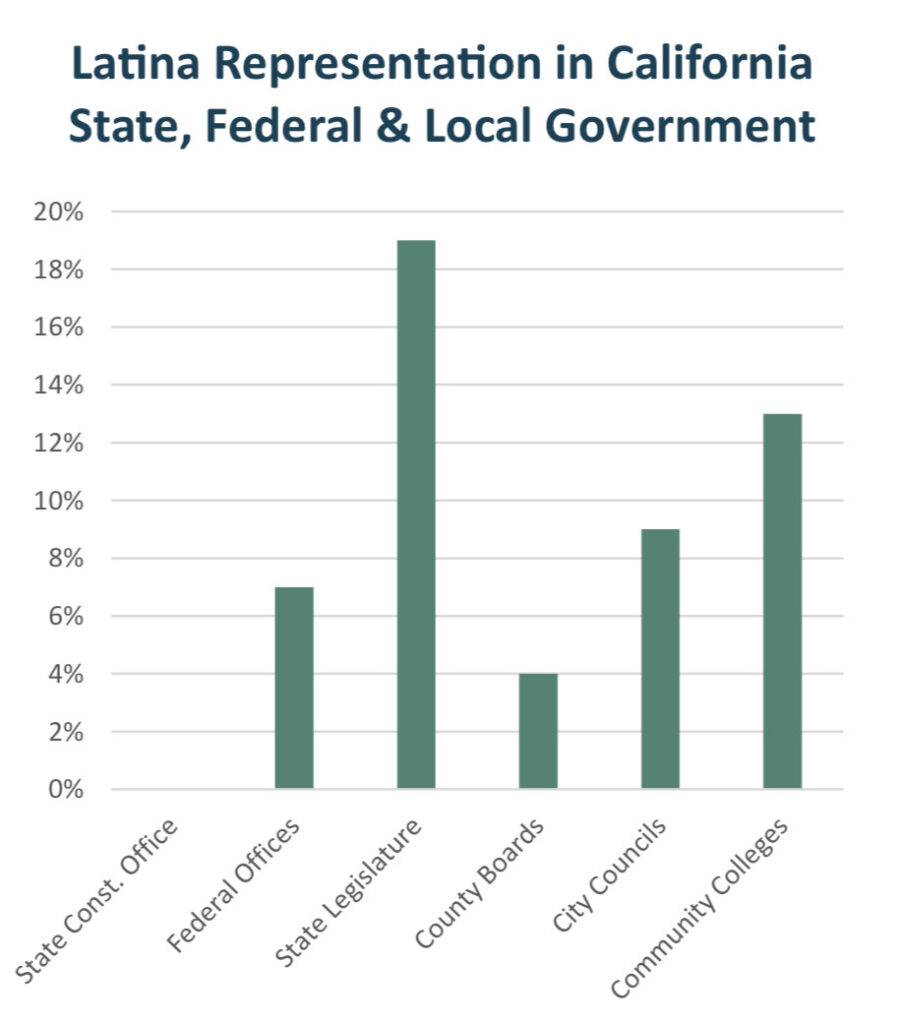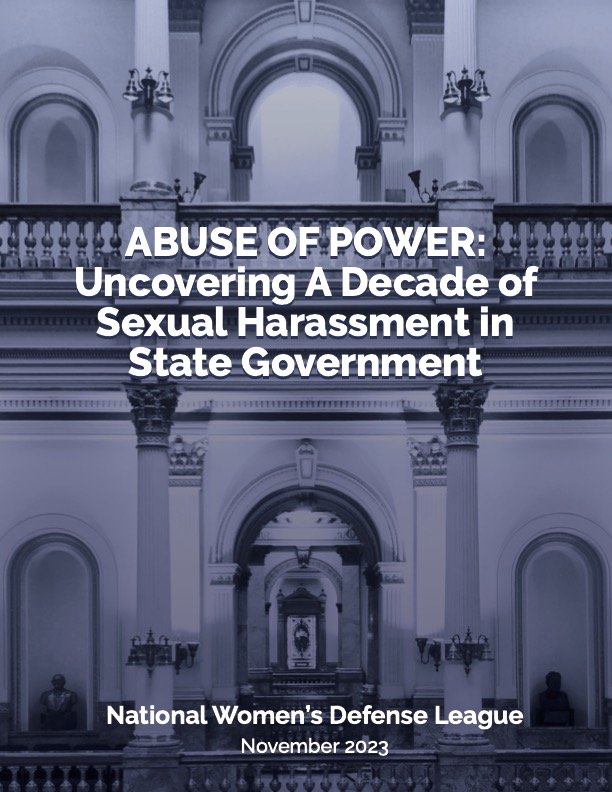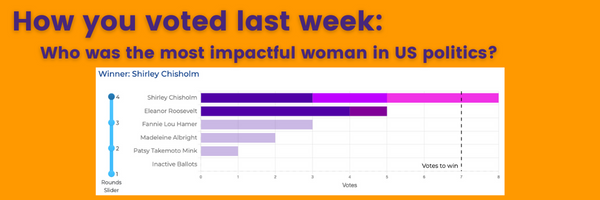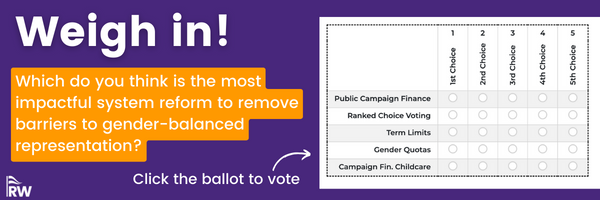
Weekend Reading on Women’s Representation is a compilation of stories about women’s representation in politics, on boards, in sports and entertainment, in judicial offices and in the private sector in the U.S. and around the world—with a little gardening and goodwill mixed in for refreshment!
It’s hard to believe December is here. I hope you are staying warm and feeling a bit of joy and hopeful anticipation this holiday season.
This week, I was reading through Forbes’ 20th annual list of the World’s 100 Most Powerful Women and noticed the scarcity of women in top political roles, with Italy Prime Minister Giorgia Meloni being the sole woman leading a G20 economy. Ten years ago, five women were heading nations among the top 25 global economies.
At RepresentWomen, we know that current progress towards gender balance is slow and uneven—but that systems solutions can accelerate progress.
In this week’s Weekend Reading, let’s examine new data and news stories on women’s representation and the solutions for the problems they highlight.
New Report Sheds Light on Latina Underrepresentation in Politics

Hispanas Organized for Political Equality (HOPE) released a new report titled ”Latina Representation in California Government,” detailing that although Latinas represent 20 percent of California’s population, their representation in elected office lags far behind that. The report covers Latina representation at all levels of government and finds that their local representation is strongest:
Latinas hold no statewide seats and have yet to see a representative hold constitutional office in California.
Latinas hold just 4 of 52 congressional seats — all in Southern California and one of whom has announced her retirement at the conclusion of the current term.
There is reason for optimism. Significant gains have been made by women and Latinas, specifically at the city council and school board levels, driving increased representation on these bodies and building a strong bench of officials who may run for higher office in the future.
Our report also found significant strength in Los Angeles, where the largest number of Latinos are registered in California, and where Latinas hold relative parity between their population and representation at all levels of government except city council.
We have also found growing Latina power in the Central Valley and on the Central Coast, where again Latinos and Latinas hold strong voter registration numbers.
‘Rethinking Women’s Political Power’: The Need for Systems Reforms

Our friends over at the Center for American Women in Politics, led by the terrific Debbie Walsh, released a timely report authored by Kelly Dittmar, “Rethinking Women’s Political Power.” This report is full of quotes from interviews with elected officials and other leaders (as pictured above), and reiterates the need for systems change and improved coordination to remove barriers to women’s entry into politics.
We are passionate about building a more cohesive movement for gender-balanced democracy through our newest initiative, the Women’s Power Collaborative, to help remedy the barriers outlined in the report.
Rethinking women’s political power requires rethinking support infrastructures for women in politics, expanding beyond candidate training and targeted campaign giving to consider alternative sites for and styles of support that will foster sustainable political engagement for a full diversity of women…
While supports specifically for political women exist in their state, they are limited in scope, capacity, and reach. Multiple interview subjects lamented the lack of coordination among organizations and programs, suggesting there is potential for more coalition-building and partnerships – similar to Georgia’s recruitment coalition – to support a diversity of women in politics…
Whether due to limited capacity, focus on self-sustainability, or other factors, existing supports for women in politics often function within silos instead of in coordination with other gender-focused or non-gendered efforts to increase political engagement and power across sites and levels.
Report on Sexual Harassment in State Government Reveals Pervasiveness of the Issue

A new report released by the National Women’s Defense League titled “Abuse of Power: Uncovering a Decade of Sexual Harassment in State Government” reveals that sexual harassment by sitting state lawmakers over the last decade is pervasive and ongoing: At least 130 statehouse lawmakers were accused of sexual harassment by 359 individuals in 45 states since 2013–with actual numbers likely three times as much due to underreporting by survivors and legislatures. The report makes clear that sexual harassment by state lawmakers isn’t a single-party issue or an anomaly–it’s a systemic and underregulated abuse of power in every statehouse across the country.
Here’s what to know about the new report’s findings:
- Both parties are to blame: Sexual harassment is not exclusive to one party, though both parties attempt to leverage it as a partisan issue. Members of both political parties commit sexual harassment at a nearly equal level.
- Little accountability or reliable recourse: Nearly 60 percent of lawmakers attempt to remain in office immediately after an accusation of sexual harassment, and in 55 percent of the incidents identified, no official action was taken against the accused elected official.
- A problem in all 50 states: The report identified specific lawmakers accused of sexual harassment in 45 states and stakeholders in the remaining five states who spoke to the problem of sexual harassment.
Sexual harassment is a problem that continues to put hundreds of people’s safety, professions, and well-being in jeopardy. In a cultural moment of reconciling the power dynamics in workplaces across the country, and despite an uptick in public reports and media coverage of unchecked harassment by lawmakers in recent years, little research has been done to identify the magnitude and scope of sexual harassment in political and government workplaces.
Are Women’s Challenges in Mexico Fixable with a Woman President?

In an article published by Refinery29, Bárbara González writes about Mexico’s upcoming election. Among the candidates are two women, Claudia Sheinbaum and Xóchitl Gálvez.
Although there are many forms of discrimination that women experience in the political, economic, and social spheres, you would expect that the prospect of a female president would bring Mexican women hope for a better future; however, both of the candidates aren’t exactly pro-woman.
This article brings up an important question on the minds of many folks working to advance women’s representation and build women’s political power: how do we ensure getting more women in the seats translates to substantive representation of the issues that women care about?
It is newsworthy for a country with a reputation for rampant machismo to potentially have a woman leading at the highest levels of government, but feminists in the country question if it will actually be effective for their struggle. Women in Mexico are still being discriminated against, attacked, and killed. Mexican women are paid much less than men. For every 100 pesos a Mexican man earns in one month, a Mexican woman makes 65. The gap grows when women have children and spend more time doing unpaid labor at home. More than 70% of Mexican women over the age of 15 have experienced at least one incident of psychological, economic, physical, or sexual violence…. It should thus come as no surprise that Mexican feminists are skeptical, if not outright pessimistic, when presented with the possibility of a presidenta…
Fátima Gamboa, director of EQUIS Justicia para las Mujeres, challenges the assumption that a presidenta will be the magic bullet that will solve Mexican women’s problems. While she acknowledges that “it is always important and that more and more positions of power and political representation are occupied by women,” she also tells Somos that “a female president does not automatically translate into improving the situation of insecurity, poverty, inequality, and violence.” Moreover, Gamboa says that the current trend of militarization, unlikely to be reversed by either of the women candidates, does not bode well for the end of violence against Mexican women…
The upcoming Mexican presidential election will undoubtedly be historic. These two candidacies are a welcome advance in terms of descriptive representation, but there is still much work to be done to address the deep-rooted issues that continue to affect Mexican women.
If you are interested in learning more about women’s political representation in Mexico, check out RepresentWomen’s report, “Achieving Gender Parity: Systems Strategies Around the World.”
Sarah Blahovec Discusses the Urgent Need to Create Space for Disabled Leaders in Politics

Sunday, Dec. 3, was the International Day of Disabled Persons. In honor of this occasion, our close ally Sarah Blahovec wrote an article for Gender on the Ballot, which reiterates the urgent need for creating space for disabled leaders within the political sphere.
As our research has demonstrated, disabled individuals, particularly disabled women, face steep barriers to political representation and are often hindered by the rules and structure of our political system. To mitigate this longstanding problem, Sarah Blahovec helped co-found Disability Victory, the first-ever organization dedicated to empowering disabled individuals to run for office.
As explained in the article, Disability Victory creates a safe, accessible space for disabled individuals to help one another combat ableism, learn to advocate for their needs, and navigate the unique challenges they face in campaigning and running for office.
As disabled people, we know that society is filled with systemic access barriers. These barriers are present in our democratic processes, from voting to running for office. We also know that disabled people are underrepresented in elected office, especially disabled women. This means that our voices are often missing as policymakers who can effect change and make our society more accessible and inclusive.
These barriers extend to the campaign trail. Over the past several years, we’ve heard from disabled candidates, campaign staff, and volunteers about the challenges they’ve encountered running for office and working on campaigns. Not only that, we’ve heard about the difficulties disabled candidates have faced in getting equal access to the information they need to run for office, from struggling to get accommodations to participate in campaign training programs to not finding answers to their questions about running for office as a disabled candidate……
Accessibility is a journey, not a destination. You can start by making simple changes, such as adding alternative text to images you share on social media, uploading videos with closed captioning, and adding a way to request accommodations on your event registration pages. These small changes can make a major impact, and you’ll soon realize that once you start practicing accessibility, it becomes a habit. So, make access a practice, and together, we can make the political arena more accessible and inclusive to millions of disabled leaders.
Rest in Power: Sandra Day O’Connor, First Woman on U.S. Supreme Court

The New York Times featured a touching tribute to former Supreme Court Justice Sandra Day O’Connor written by Pulitzer Prize-winning reporter Linda Greenhouse.
President Ronald Reagan named O’Connor to the Supreme Court in 1981, making her the first woman in U.S. history to serve on the Court. The trailblazer broke a consequential glass ceiling in American government and paved the path forward for future female Supreme Court Justices Ruth Bader Ginsberg, Sonia Sotomayor, Elena Kagan, Amy Coney Barrett, and Ketanji Brown Jackson–inspiring women who have exemplified service and leadership!
RepresentWomen’s ‘Women on the Supreme Court’ highlights all the women who have served on the Supreme Court.
Justice O’Connor’s recollection of an attack of nerves may have been charming to her audience of Supreme Court bar members and Washington insiders but scarcely plausible to them: It was simply hard to imagine a nervous Sandra Day O’Connor. Athletic (she enjoyed golf, tennis, skiing, and riding), with a strong grip and a piercing gaze that could turn into an intimidating stare, the public Justice O’Connor was the picture of self-confidence.
On the bench during an argument session, she often asked the first question, and it was usually one to strike fear into the heart of even an experienced Supreme Court advocate: Is your case properly in this court? Why shouldn’t we dismiss it as moot? What gives your client standing?…
The route to success in arguing a case before Justice O’Connor lay not in invoking legal doctrine or bright-line rules but in marshaling the facts to demonstrate a decision’s potential impact. Justice Anthony M. Kennedy described her with admiration as a pragmatist, which he defined as “paying attention to real-world consequences.” Her jurisprudence, Justice Kennedy wrote in a tribute published after her retirement, was “grounded in real experience.”
The results from last week’s ranked-choice voting poll are in! Readers weighed in on who they thought was the most impactful woman in U.S. politics, and the majority of voters named Shirley Chisholm!

Continuing with the theme of solutions to increase women’s representation: Which do you think is the most impactful system reform to remove barriers to gender-balanced representation? Let us know with this poll!

P.S. Our Ranked-Choice Voting and Representation Toolkit is now live! With this one-stop shop, you’ll have instant access to our latest and most impactful resources on RCV and its positive influence on women’s representation in government.
The best part? You won’t need to worry about missing out on updates—our toolkit automatically refreshes, keeping you informed with the most current information. Bookmark the toolkit and empower yourself to speak confidently about RCV’s benefits for women’s political power.

Up next:
U.S. democracy is at a dangerous inflection point—from the demise of abortion rights, to a lack of pay equity and parental leave, to skyrocketing maternal mortality, and attacks on trans health. Left unchecked, these crises will lead to wider gaps in political participation and representation. For 50 years, Ms. has been forging feminist journalism—reporting, rebelling and truth-telling from the front-lines, championing the Equal Rights Amendment, and centering the stories of those most impacted. With all that’s at stake for equality, we are redoubling our commitment for the next 50 years. In turn, we need your help, Support Ms. today with a donation—any amount that is meaningful to you. For as little as $5 each month, you’ll receive the print magazine along with our e-newsletters, action alerts, and invitations to Ms. Studios events and podcasts. We are grateful for your loyalty and ferocity.





